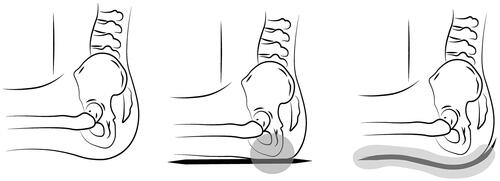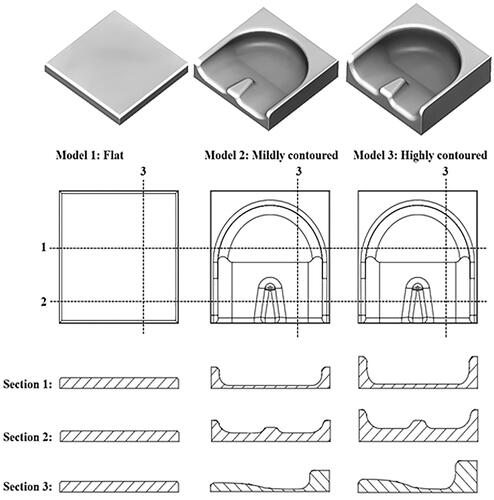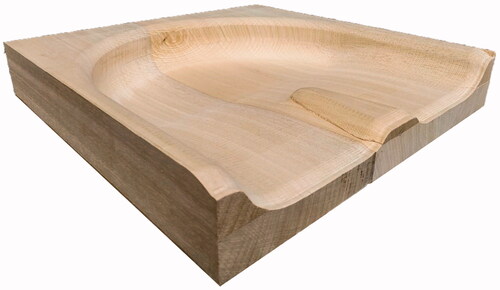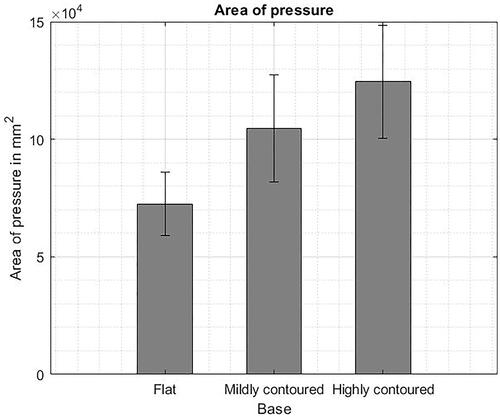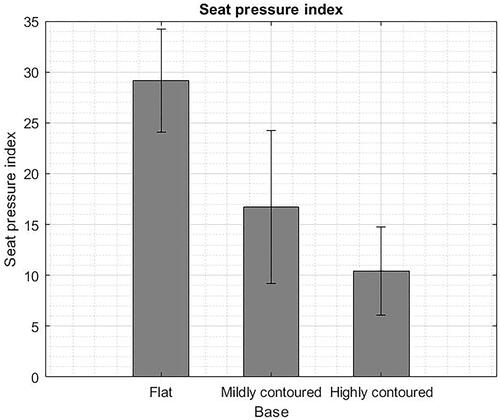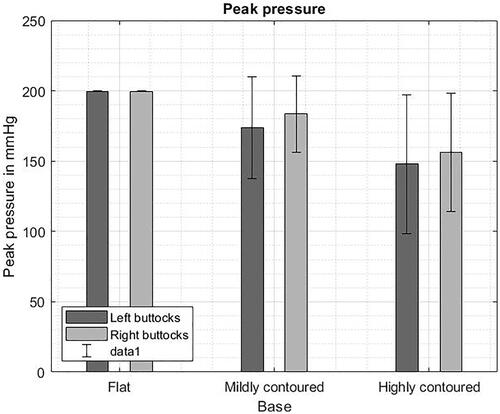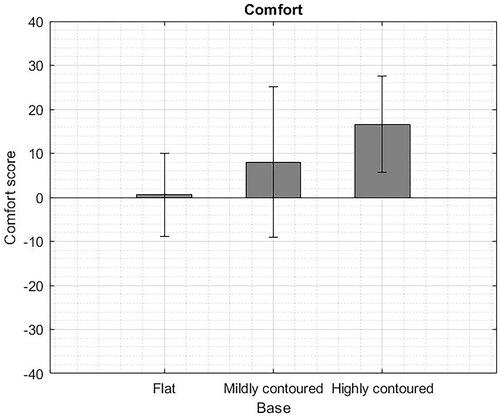 ?Mathematical formulae have been encoded as MathML and are displayed in this HTML version using MathJax in order to improve their display. Uncheck the box to turn MathJax off. This feature requires Javascript. Click on a formula to zoom.
?Mathematical formulae have been encoded as MathML and are displayed in this HTML version using MathJax in order to improve their display. Uncheck the box to turn MathJax off. This feature requires Javascript. Click on a formula to zoom.Abstract
Purpose
This research paper examines how contouring of a wheelchair seating base can help prevent pressure sores by distributing pressure over the buttocks. Contouring wheelchair cushioning is already done to some extent and has proved to be beneficial for pressure distribution. We researched the effect of contouring the seating base, and whether contouring the seating base affects effectiveness in pressure distribution and perceived discomfort.
Materials & methods
13 healthy participants performed a within-subject experiment with three differently contoured seating bases. Perceived comfort and seating pressure were measured for each condition.
Results
Results indicate that a more contoured base is positive for both comfort and increased pressure distribution.
Conclusions
Contoured seating bases can provide increased comfort and improved pressure distribution over flat seating bases. Future research should examine the effect of contouring on stability, as well as compare the effects of contoured seating bases and contoured cushions.
We evaluated the comfort and pressure characteristics of three differently contoured hard seating bases for a wheelchair. The outcomes of the research shows that providing increased contour to seatings could be beneficial to reduce pressure peaks in the buttocks.
Contour in the seating is conventionally created by shaping the cushions, this research shows the possibility of using a hard base underneath a cushion to create the desired contour.
Implications for rehabilitation
Introduction
Paralysis is the inability to move parts of the body. When it affects the legs, it is called paraplegia. Pressure ulcers, or more commonly known as pressure sores, are injuries primarily caused by prolonged pressure on the skin. These injuries affect the skin and underlying tissue and can result in a range of small open wounds and blisters, to deep wounds that may reach the muscle and bone. In total there are approximately 131 million people in the world in need of a wheelchair [Citation1]. Part of this group are people with paraplegia, of whom many experience pressure sores. 85% experience one at least once in their lifetime [Citation2]. The majority of people with paraplegia who experience pressure sores remark problems they experience in their everyday lives as a result of these sores. Some of these problems are a lack of social relations, self-care and outdoors activities [Citation3]. This shows that pressure sores are not only affecting these persons physically, but mentally as well.
Constant sitting means that the weight of the upper body is constantly pressing on the buttocks. Changing positions regularly can reduce the risk of developing a pressure sore. However, people with paraplegia are not able to move their lower half and they do not change position automatically and unconsciously. This needs to be a conscious action, making it easy to forget [Citation4]. Not being able to feel the lower part of the body also means that they do not feel a(n) (upcoming) sore. This results in not being able to react to paraesthesia signals, a tingly feeling caused by pressure or damage of nerves, to prevent the sore from getting worse [Citation5]. For people with paraplegia, pressure sores are mostly formed onto the ischias and sacrum [Citation5]. Previous research has shown that a better pressure distribution is important for, for example people with a spinal cord injury [Citation6], while it results in less pressure sores because the highest peaks on, for instance, the seating bones are lower and the pressure is distributed over a larger area [Citation7,Citation8]. Previous literature has shown that contoured cushions have a positive effect on the pressure distribution of the buttocks [Citation9].
Discomfort in a wheelchair is also recognised as being a common problem [Citation10,Citation11]. People sit in their wheelchair for a long time, and certain pains like pressure sores and back pain can arise. Other factors like temperature, stability, positioning and stiffness also contribute to wheelchair discomfort [Citation10,Citation12]. This makes discomfort an essential parameter for wheelchair problems.
Research suggests that contoured cushioning is beneficial for pressure distribution and reducing discomfort in comparison to a non-contoured seating. However, there is a lack of research on the effect of the level of contour in wheelchair seating [Citation13]. In addition, the contour is usually applied to the cushion itself and not to the underlying base. Therefore, in this paper we explore different levels of contouring through a hard shaped base placed under cushions.
A hard base better keeps its shape over a longer period of time while it is less vulnerable to deformation. Therefore, it could be more durable and better keeps its positive characteristics when being seated on for a longer time. We present the design and manufacturing of three different 3 D modelled bases: a flat, mildly contoured and highly contoured base. Finally, we present a preliminary study exploring the effect of contoured seating.
Related work
Parameters for improving wheelchairs
The following parameters form important aspects for future improvement for wheelchair users: cushioning and its pressure distribution [Citation7–9], prevention of pressure ulcers [Citation2,Citation3], and wheelchair discomfort [Citation10–12]. This is true for everyone in need of a wheelchair and especially for those who use their wheelchair daily. We focussed on the core and some of the most addressed parameters which research implies are influenced by contour: discomfort [Citation14] and pressure distribution [Citation13]. Research implies that contour is beneficial for these parameters, in comparison to no seating contour.
Pressure distribution
There is a significant difference between pre-contoured foam seats and regular wheelchair cushions (or flat foam) [Citation9]. Contouring is done to match the anatomical shape of the human body. As can be seen in , the seating bones or the ischium are positioned lower than the thighs when sitting. Not using contour in seating can result in peak pressure under the ischium [Citation9]. By contouring the cushion, there is support underneath the thighs which takes some load off the ischium. The contour also helps to reduce deformation when the body matches the shape of the cushion. Therefore, contoured foam results in less distortion of the tissue and lower pressure points compared to flat foam [Citation9]. This, and related research, shows the benefit of contoured cushioning over flat cushioning. However, research does not adequately look into different levels of contour [Citation13]. Pressure on the buttocks is often measured with the use of a pressure mat. The advantages of a pressure mat are that the pressure is measured on multiple places and can be easily visualised.
Discomfort
Wheelchair seating discomfort is a common problem among wheelchair users [Citation10,Citation11]. Able-bodied persons using wheelchairs experience a high incidence of back pain [Citation11]. This arises concern, also for people who cannot feel certain parts of their body. Wheelchair users can sit in their wheelchair for up to 12 continuous hours a day [Citation9,Citation15]. Therefore, discomfort needs to be prevented. Discomfort is a subjective term which can be influenced by a variety of factors. It is stated as a coming together of other parameters, such as temperature, stability, positioning and stiffness. These factors are listed in a Wheelchair Seating Discomfort Assessment Tool [Citation12]. Research has touched upon the relation between taking into account a person’s body contour and the benefit of implementing the contour in a seating system to best position the person and support them in comfort [Citation14]. This comfort is also related to not sliding out of the wheelchair, which might be helped as well with a solid seating [Citation14].
Method
In this study, we evaluated the effect of level of contour of a hard wheelchair seating base on two parameters important for wheelchair seating: pressure distribution and discomfort. We formulated three hypotheses for these parameters:
H1: The more contoured the base of a seating is, the larger the area of pressure and the lower the SPI.
H2: The more contoured the base of a seating is, the lower the pressure peaks are.
H3: Increased contour will provide less discomfort compared to a flat base. We assumed that contoured seating is the least discomfortable for the participants because it provides comfortable support and stability. This is in line with previous research [Citation13,Citation14].
Study materials
Three seatings were made to test with different levels of contour. These seatings were a combination of a 3 D modelled base and a 2 cm thick 50 by 50 centimetres PerfoLatex cushion placed on top. The first base was flat, with no contour and a seating depth of 0 cm. The second was mildly contoured with a seating depth of 5 cm and the third base had a high level of contour with a seating depth of 10 cm.
The contoured models were based on research done on the contour of existing wheelchair cushions, feedback from an occupational therapist and measurements done on the buttocks of 5 persons (3 F, 2 M), aged 18 to 20 years old. These measurements were done on healthy young adults, representative for the subject group involved in the evaluation. Average measurements were used to determine a generic shape for the cushion. The measurements were done by tracing the buttocks of a sitting person, both the contact area of their bottom to the surface, and the total area hovering over the plane (representative of the largest width of the buttocks). The difference between the contact area and the total area was measured to get an insight in the roundness of the buttock (, ).
Figure 2. Measurement points buttocks for 3D model, contact area (inside contour) and hovering area (outside contour).
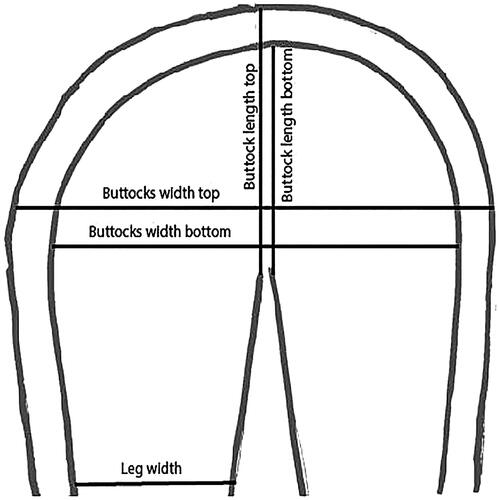
The measurements were used as a starting point for the highly contoured 3D model in Solidworks. The bases were made by 3D milling the model in wood ().
To change contour, two explanatory parameters of contour were taken into account: maximum depth and surface. By adapting the amount of depth of the highly contoured model the mildly contoured model was made. This was done by rescaling the highly contoured model to half of the maximum depth ().
Participants
Since this was a preliminary study, we recruited healthy young adults instead of wheelchair users. Our participants consisted of 7 male and 6 female students. Since our seating bases were shaped according to a generic model, we only selected participants who were able to sit in the contoured shapes, while having body contact with the sides and the bottom of the base. Informed consent was obtained from all participants before the study.
Measures
We measured pressure distribution and perceived discomfort. Pressure distribution was measured by means of three different measures: area of pressure, seat pressure index, and peak pressure. A BodiTrak Smart Seat pressure mat [Citation16] was used to record pressure. This mat has 1024 pressure sensors and is linked to a software that can record pressure frames.
Area of pressure
Area of pressure is defined as the surface of the contact area between the participant and the seating where the pressure is over 5 mmHg. An increased area of pressure indicates better pressure distribution.
Seat Pressure Index
De Seat Pressure Index (SPI) is a single, dimensionless value derived from a comparison between the real measured pressure distribution and an ideal pressure distribution [Citation17]. This ideal pressure distribution in a seated posture is proposed as a homogeneously divided pressure of 30 mmHg [Citation17]. The SPI calculation includes an average of values exceeding a threshold, a measure of dispersion of these same values, and the relative amount of the pressure mat that is loaded. The smaller the index, the closer the ideal pressure distribution is approached. The SPI is calculated according to the following formula:
Mean30 is the average pressure value of all sensors with pressure higher than 30 mmHg.
Sd30 is the standard deviation of all sensors with a pressure higher than 30 mmHg (spread).
N is the number of sensors in the pressure mat (in our case: 32 × 32 = 1024).
n5 is the number of sensors registering a pressure above 5 mmHg.
Peak pressure
Peak pressure is the highest pressure level measured with the pressure mat. Lower peak pressure indicates improved pressure distribution. We measured peak pressure for both the left and the right buttock.
Perceived discomfort
Perceived discomfort was measured with a survey derived from the Tool for Assessing Wheelchair disComfort (TAWC) [Citation10,Citation12]. Only the General Discomfort Assessment was used. This survey consists of a range of statements about comfort and discomfort, to which participants indicate their agreement, rating from “strongly disagree” to “strongly agree”, on a 7-point Likert scale, with a range from −3 to 3. Answers related to discomfort are rated negatively while answers related to comfort are rated positively. The answers to the statements are averaged, resulting in a value between −39 and 39, indicating the level of perceived discomfort (higher value indicates increased comfort).
Study setup
In our study, we evaluated discomfort and pressure distribution on three different wheelchair seatings with varying levels of contour. We applied a within-subjects design: each participant evaluated all three seatings. The order in which participants evaluated the different seating designs was randomised over all participants. For each participant and seating, we measured perceived discomfort and pressure.
Study procedure
Before each measurement, a researcher would prepare a seat by covering the seating base with the BodiTrak Smart Seat pressure mat [Citation16] and make sure there were no folds which could cause measuring errors. Next, the participant would be seated on the seating. The legs were positioned so that the thighs were horizontal and formed a 90° angle with the lower legs. The participant was asked to sit for 7 min to let the buttocks adjust to the seat, in order to provide a more realistic reading. This value was based on the experience of therapists from the rehabilitation clinic involved in this study. We then measured the pressure for 1 min. The measurements were averaged over time for further analysis. [Citation7] After each measurement, the participant was asked to complete the discomfort assessment survey. Finally, the participant was asked to stand up and walk around, during which time the next seating could be prepared by the researchers.
Results
shows a summary of the results, while summarises the outcomes of comparisons between the three seating conditions.
Table 2. Summary of results on area of pressure, peak pressure, seat pressure index, and perceived comfort.
Table 3. Summary of comparisons between seating conditions.
Pressure distribution
We analysed three measures for pressure distribution: area of pressure, SPI (Seat Pressure Index) and peak pressure.
Area of pressure
shows that the average area of pressure increases with increased contouring of the seating base. Paired-sample t-tests revealed that the differences between the three different conditions were significant. One outlier was observed, showing no difference between the bases. In this case the bases turned out to be too wide for the participant, thus eliminating the effect of contour ().
Seat Pressure Index (SPI)
A significant difference in Seat Pressure Index was found between all conditions. In general, more contoured bases resulted in a lower SPI value, indicating closer approximation of an ideal, homogeneously divided pressure of 30 mmHg.
Peak pressure
shows the peak pressures of the left and the right buttock for every base. Unfortunately, a ceiling effect can be observed for the “Flat” condition. This is caused by a limitation of the pressure mat we used; the mat cannot measure pressures higher than 200 mmHg. lists comparisons between the three conditions for both the left and right buttocks. There was no significant difference between the flat and mild condition for peak pressure for the right buttock. However, significant differences for the right buttock were found between the flat and high condition and the mild and high condition. There was no significant difference between the mild and high conditions for peak pressure on the left buttock. However, there were significant differences between the flat and mild condition and the flat and high condition, for the left buttock ().
Discomfort
We found the highly contoured base to be the least discomfortable; comfort was generally perceived positively across participants. Our results show that the average comfort rating increases with increased contour, but no significant difference was found between the flat base and mildly contoured base conditions. The other conditions did show a significant difference ().
Discussion
We compared the effect of contoured seating bases on pressure distribution and perceived discomfort. Our results indicate that increased contouring of the seating base leads to a larger area of pressure, lower SPI, lower peak pressure and lower perceived discomfort, which supports our hypotheses. There is however an interesting difference between the peak pressures on the left and right buttocks. While for both there is a significant difference between the flat base and the highly contoured base, there are different outcomes when comparing the flat base with the mildly contoured base and when comparing the mildly contoured base with the highly contoured case. On both sides one of the comparisons is significant and the other is not. This might be caused by the human body not being perfectly symmetrical or the preference of individuals to lean to a certain side.
Limitations
Our study has been conducted with students who have no disabilities and who were matched to fit the seating bases. Hence, our results cannot be generalised to other users such as people with paraplegia. They merely give insight into whether the effect of contouring seating bases warrants further research, for example in people with paraplegia.
There were some limitations caused by the BodiTrak measuring mat that was used in this study. Besides the occurrence of clipping in the “flat” condition, the contoured bases caused folds in the pressure mat, sometimes resulting in artificial pressure peaks.
While these limitations have impacted the results, they do not influence the conclusion. Without clipping, it is likely that peak pressures for the “flat” condition would have been higher, increasing the differences with the other conditions, and strengthening our conclusions.
Stability
Beyond pressure distribution and perceived discomfort, another parameter that is important to wheelchair users is stability. 47% of wheelchair users who have used their wheelchair for over 11 years (non-institutionalized users of manually propelled wheelchairs in the US), have been through injuries due to instability incidents [Citation18]. Of 36000 wheelchair related injuries a year in the United States, 75% of these incidents are due to tips and falls [Citation19].
Limited stability could hinder people in doing certain tasks like reaching out to grab an object. Research already suggests that a contoured cushion is beneficial for stability, compared to a flat cushion [Citation20]. Further research could investigate whether increased contouring can further improve stability. We expect that the contoured edges on a solid base will provide even more support and a barrier to falling and will be more durable while it is less vulnerable for deformation. Research also suggests that a solid base could prevent people from sliding off their seat [Citation14].
While a hard contoured base, such as those evaluated in this study, might increase stability because of its tendency to not deform under shifting pressure (e.g., a person leaning towards one side), an important aspect is the surface material of the hard base. The surface of the hard base should provide sufficient friction for the user to prevent sliding or slipping over the hard base.
Future research
Conventionally contour is created through the shaping of the cushion [Citation9,Citation13]. In this research we used a hard-base underneath the cushion to provide contour. Future research could look into the effect of using the hard base in comparison to shaping the cushion. This preliminary research shows that effective contouring can be provided with a hard base.
Conclusion
Traditionally, studies on contoured seating have focussed on comparing flat cushions with contoured cushions. In this paper we try to expand this research by 1) looking at the influence of the degree of contour, and 2) by using a contoured base, rather than the contoured cushion that is conventionally used. After evaluating perceived discomfort and pressure distribution, we found that increased contouring has a significant positive effect on the SPI, the area of pressure and peak pressures on the buttocks. Additionally, we found that increased contour positively correlates with perceived comfort. Future research should examine the effect of contouring on stability and compare the effects of contoured seating bases with contoured seating cushions.
Acknowledgements
We want to thank Peter Schraven for his professional insights and for his help with designing the shape of the bases.
Disclosure statement
No potential conflict of interest was reported by the author(s).
Table 1. Measurements of buttocks contact area in centimetres.
Additional information
Funding
References
- Wheelchair Foundation. Wheelchair needs in the world; 2016, July. Available from: https://www.wheelchairfoundation.org/fth/analysis-of-wheelchair-need/.
- Byrne DW, Salzberg CA. Major risk factors for pressure ulcers in the spinal cord disabled: a literature review. Spinal Cord. 1996;34(5):255–263.
- Sapountzi-Krepia D, Soumilas A, Papadakis N, et al. Post traumatic paraplegics living in Athens: The impact of pressure sores and UTIs on everyday life activities. Spinal Cord. 1998;36(6):432–437.
- Nageswaran S, Vijayakumar R, Sivarasu S. Design evaluation of an automated bed for early detection and prevention of decubitus ulcers in nonambulatory patients. ASME J Med Devices. 2014;8(2)020925–020925-2.
- Chenu O, Payan Y, Hlavackova P, et al. Pressure sores prevention for paraplegic people: Effects of visual, auditory and tactile supplementations on overpressures distribution in seated posture. Appl Bionics Biomech. 2012;9(1):61–67.
- Gutierrez EM, Alm M, Hultling C, et al. Measuring seating pressure, area, and asymmetry in persons with spinal cord injury. Eur Spine J. 2004;13(4):374–379.
- Aissaoui R, Kauffmann C, Dansereau J, et al. Analysis of pressure distribution at the body-seat interface in able-bodied and paraplegic subjects using a deformable active contour algorithm. Med Eng Phys. 2001;23(6):359–367.
- Battiato R, Corbin C, Kenderish J, et al. Minimizing pressure injuries among wheelchair users. Rehab Manag. 2017;30(1):28–34.
- Sprigle S, Chung KC, Brubaker CE. Reduction of sitting pressures with custom contoured cushions. J Rehabil Res Dev. 1990;27(2):135–140.
- Crane B. General Information about the tool for assessing wheelchair discomfort (TAWC). (PA): University of Pittsburgh; 2007.
- Harms M. Effect of wheelchair design on posture and comfort of users. Physiotherapy. 1990;76(5):266–271.
- Crane BA, Holm MB, Hobson D, et al. Development of a consumer-driven wheelchair seating discomfort assessment tool (WcS-DAT). Int J Rehabil Res. 2004;27(1):85–90.
- Tasker LH, Shapcott NG, Watkins AJ, et al. The effect of seat shape on the risk of pressure ulcers using discomfort and interface pressure measurements. Prosthet Orthot Int. 2014;38(1):46–53.
- Rader J, Jones D, Miller LL. Individualized wheelchair seating: reducing restraints and improving comfort and function. Top Geriatr Rehabil. 1999;15(2):34–47.
- Stockton L, Parker D. Pressure relief behaviour and the prevention of pressure ulcers in wheelchair users in the community. J Tissue Viability. 2002;12(3):84–99.
- “Smart Seat”, BodiTrak [Online] [cited 2019 Sep 23]. Available from https://www.boditrak.com/products/medical/wheelchair.php.
- Maurer CL, Sprigle S. Effect of seat inclination on seated pressures of individuals with spinal cord injury. Phys Ther. 2004;84(3):255–261.
- Kirby RL. Wheelchair stability: important, measurable and modifiable. TAD. 1996;5(1):75–80.
- Kirby RL, Sampson MT, Thoren FA, et al. Wheelchair stability: effect of body position. J Rehabil Res Develop. 1995;32(4):367.
- Aissaoui R, Boucher C, Bourbonnais D, et al. Effect of seat cushion on dynamic stability in sitting during a reaching task in wheelchair users with paraplegia. Arch Phys Med Rehab. 2001;82(2):274–281.

